Houston Astros: Who should get the 26th roster spot?

With changes to the MLB roster sizes for 2020 who should claim the Astros last roster position?
To Astros fans’ relief, the 2020 season begins soon, but with a new season comes a few new rules. One rule change is the addition of one more spot for the regular season MLB roster. Up from 25 rostered players, each team will be able to roster a 26th player, which was previously the rule only for doubleheader games from the 2012 season until now.
Major league teams can have a maximum of 13 pitchers on the roster, so it is to be assumed most teams will carry a 13/13 split of pitchers and position players for the majority of the season. After all this preface, the main question here is who the Astros 26th player should be.
For this analysis, we’re just taking a look at position players. Even though the Astros opening day 25 man roster from 2019 had 13 position players to 12 pitchers, this is a rarity to have the roster composition like that. Many of the players that will be mentioned in this article have major league service time and will more than likely contribute at some point to the big-league team this season.
Much like how it takes a village to raise a child, it takes a 40-man roster to play an MLB season. Also, more than one of these candidates for the 26th roster spot could make their way to Houston for opening day on March 26th. The only players who aren’t in consideration for the 26th man are those who would be everyday players.
Kyle Tucker will not be on this list, as it is safe to assume if he makes the opening day roster it will be to play (almost) every day. The same is true for Abraham Toro — if he is called upon for the opening day roster it is believed he would be a semi-regular or match-up player.
This list contains seven different Astros who have a good possibility of being the 26th man. They will be listed from most likely to least likely. So here we go, the case for the 26th man.
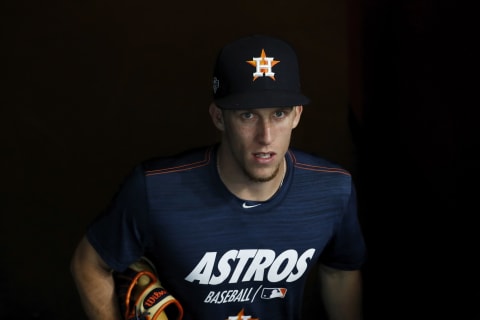
Early on this spring, Straw has shown he is all about that “Dad strength.” Blessed by the powers of a newborn, Straw has already shown that the tinkering with his swing he did in the offseason is paying off.
Now, we all know that spring homers don’t matter, but one can’t take away the fact that Straw has three homers in minimal playing time this spring, almost matching his professional career mark in dingers at five (four over five years in the minors and one big league homer). The most recent four-bagger Straw connected with showed more leg-strength than anything else as he proved why he is considered one of the fastest in the league with an inside-the-park homer.
Straw’s speed alone makes an amazing case for a big-league roster spot, but his ability to get on base and flexibility in the field make him one of the top candidates for this position. Straw played 121 innings in the outfield last year, which isn’t surprising as he is a natural outfielder.
Fangraphs rated his outfield UZR as average and UZR/150 projected him to be an above-average fielder given the chance with his strongest play in left field. The shocker was his transition into an infielder. When the need for a backup shortstop arose, Straw stepped up and proved he could get the job done.
Even though his metrics graded him to be average to minimally below average at short, he provided 170 innings of totally acceptable play. With even more work at short and the skill set Straw has, he could become a very serviceable infielder. With his speed, ability to get on base and ability to play multiple key positions, he is most likely to be the Astros’ 26th player.
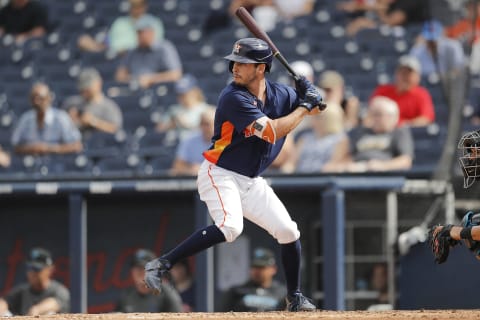
If two players on this list are rostered by the big league club on March 26th it will be Stubbs and Straw. Stubbs got his first taste of the big leagues last year and had some timely hits and was just honestly a joy to watch. Much like Straw, he proved he could move around the diamond and didn’t have to stick at one position to make contributions to the big league team.
Stubbs, a catcher, saw 68.1 innings behind the dish in his freshman season but also tallied 19 more innings in the outfield. Add that to 31 innings he played at the keystone in Triple-A and he has built a fair amount of stock within the Astros system.
It is really hard to say how successful of an outfielder he would be with regular time in the grass tallying only 19 total big-league innings as a gauge, but Fangraphs did rate his time last year in the outfield as positive, if only minimally. As a catcher, Stubbs’ defensive ratings are a little bit of a mixed bag. According to Baseball Savant, he would be rated in the top five in second base pop-time and the top ten in arm rating for catchers from the 2019 season.
Despite his ability to get the ball up the field, his pitch-framing skills measure out to be well below average. Through 231 pitches caught in 2019, Stubbs had a 39.8% strike rate. This percentage would rank him almost three percent lower than the last qualified catcher on the Baseball Savant leaderboard, Isiah Kiner-Falefa.
However, below-average pitch-framing skills shouldn’t hurt Stubbs’s chances of making the team. As the third catcher and utility player, his baserunning, ability to play positions in the infield and outfield and his infectious smile make him a top candidate to be the Astros 26th man.
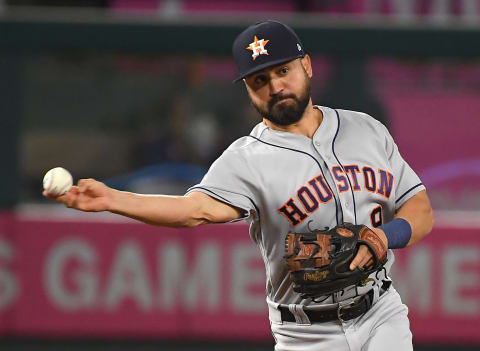
Mayfield made his dreams come true last year after six full seasons of minor league ball. Up until then, we had only seen glimpses of “Super Jack” wearing his orange and blue superhero uniform during spring training.
Even though Super Jack might not be an All-Star-caliber player, he has an all-star-caliber attitude. A player doesn’t have to hit like Bonds or field like Hayes to ignite a spark on a team. Jack Mayfield has intangibles.
In the digital age of sabermetrics and Statcast, intangibles aren’t talked about much anymore. This guy has them. His exuberance to play and the ability to wear any glove in the infield makes him a welcomed addition to the roster.
Mayfield has never lit the pitching up in the minors like Tucker or Yordan Alvarez, but he does own a very serviceable .272 minor league batting average with above-average peripheral stats. At the major league level, he had a hard time making adjustments and only had a hard-hit rate of 20.8 percent, which is well below the MLB average at 34.5 percent. That is the beauty of the 26th man — whoever is called on for this position doesn’t need to hit .300 with 30 homers and 100 RBIs.
The player for this roster spot needs to be able to play multiple positions, have decent at-bats and be a good clubhouse presence. Looking through Mayfield’s minor league career, he has shown he can adjust to the level of play after extended time in each level of pro-ball.
Mayfield could be the perfect 26th man as he doesn’t need everyday at-bats, and with more experience at the major league level, he could possibly produce at the plate closer to his minor league numbers.
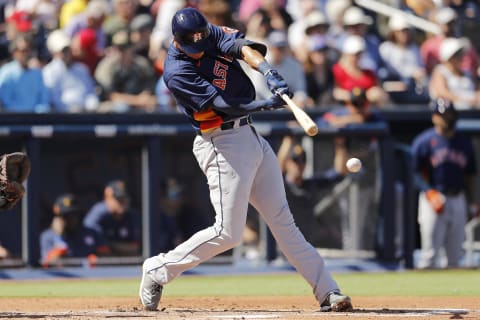
Jones has not seen a pitch at the major league level. He is, however, on the Astros 40-man roster. He played a full four-year career at Gonzaga and was an absolute doubles monster his senior year for the Bulldogs.
From there, he was drafted by the Astros in the 19th round. Jones’ strikeout-to-walk rate in his college career hasn’t translated the same in pro baseball, but with age and maturity on his side, he has unlocked power at the plate, which he didn’t possess while at Gonzaga. He has played the corner positions — infield and outfield — during his minor league career.
Even though he has primarily played first base over his four minor league seasons, he has shown the ability to make the routine plays at the corner outfield positions. If Jones made the roster as the 26th man, it would probably be behind Aledmys Diaz on the depth chart as a backup first baseman and left fielder.
The good news about Jones is he is still relatively young. This upcoming season will be his age-26 season, and last year in Triple-A he had his best overall offensive season. In 125 games with Round Rock, he slugged 22 long balls and 28 doubles while having an OPS almost touching the “great” echelon at .889.
This extra roster spot is a new commodity that might warrant more aggressive roster moves. The 26th man spot could be the perfect proving ground for a 26-year-old rookie with promise. It could also be worth giving him a look in the show as the entire outfield could possibly need to be replaced for the 2021 season.
We are getting to the portion of the list that will be considered “long-shots.” This long-shot status isn’t based primarily on their professional playing careers, more so that they are not on the 40-man roster. The Astros 40-man does sit at 39 right now so one addition could be made without having to remove anyone.
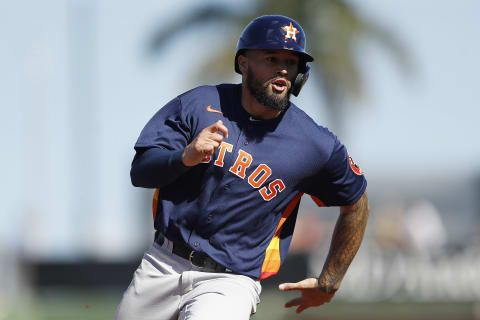
Tanielu has the longest minor league career to be recognized here as having a chance for the 26th roster spot. He has six minor league seasons under his belt, five of them being full seasons. He missed the majority of the 2017 season recovering from ACL surgery.
Outside of the 2017 season, Tanielu has posted very serviceable numbers at the plate in every stop of the minors. He has a relatively low strikeout rate and is a good contact hitter who has shown flashes of good pop with a career minor league .444 slugging percentage.
Tanielu matches the trend with the rest of the players profiled in this article, as he can play all over the field. Primarily a third baseman, he has seen significant innings at second and first base as well. His minor league career range factor numbers don’t grade him out to win a Gold Glove anytime soon, but make him comparable to Starlin Castro at second base and Chris Johnson at third.
With 317 career innings at first base in the minors, his best position seems to be with a “3” written beside his name in the position slot. Tanielu is not on the 40-man roster but is a non-roster invitee to spring training this year.
At the writing of this article, Tanielu has not seen any time on the field this spring, and he’s the only name on this list who hasn’t had an at-bat. The longer it takes for Dusty Baker to pencil Tanielu’s name into a spot, the likelihood of him making the 26th spot diminishes.
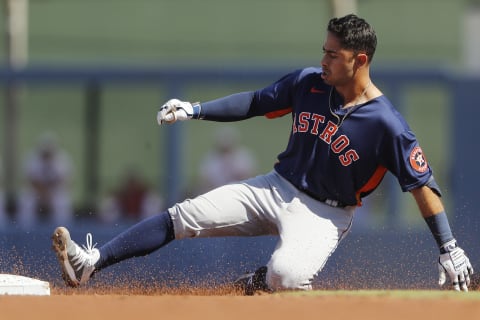
De Goti was drafted out of Barry University in the 15th round of the 2016 draft. He had a spectacular senior year at Barry after having three under-performing years for California State, Long Beach. He went from having a .414 OPS in 73 games for CSULB to a 1.186 OPS in 46 games with the Parrots.
De Goti played in all three levels of minor league ball for the Astros in 2017, his first full season of pro ball. The past two seasons have seen him be very successful at the Double-A and Triple-A levels. De Goti has averaged a .783 OPS with a 43 percent walk-to-strikeout rate.
As a non-roster invitee to Spring Training, he is coming into his age 25 season and coming off of two very good seasons. In 2018 he was a Texas League All-Star and in 2019 named an organizational All-Star.
De Goti might not have big-time college career numbers but he has shown the ability to adapt in every stop of his minor league career. Not only has he shown to be productive with the stick, he also has shown he is pretty good with the leather. Throughout his minor league career, he has played at every infield position outside of first base plus a handful of games in left field.
This type of versatility has to be key when determining who will win the 26th spot. Baker seems to also be taking a close look at De Goti, as he has been written into the lineup a couple of times already this spring. Even if he doesn’t make the team out of Spring Training, he could be in Houston sometime this season.

Ferguson has been in the Astros system since he was a 22-year-old freshly drafted out of Belmont. After being taken in the 19th round of the 2015 draft, all he has done is hit. Through five minor league seasons, he has managed a .845 OPS with 46 long balls and 92 stolen bases.
Ferguson is unlike anyone else on this list as he is only an outfielder, but is very capable of playing all three outfield positions. He has logged more than 1,000 innings in center and left field while only being 55 innings short of the millennium mark in right field. As a center fielder, his range factor lines him up as a comparable defender to Vernon Wells or Shane Victorino.
More from Climbing Tal's Hill
- Just how much better is the Houston Astros playoff rotation than the rest?
- Houston Astros: A Lineup Change to Spark Offense
- Astros prospect Hunter Brown throws 6 shutout innings in debut
- Always faithful Astros World Series champion Josh Reddick defends the title
- Michael Conforto declines Astros’ 2-year, $30 million offer
Ferguson hasn’t hit worse than .275 in any of his full minor league seasons. Regardless of how well he has hit and fielded in the minors, the Astros do have one of the most stacked outfields already with major-league talent not having room to play every day as is.
Ferguson is the longest of long shots to make the team out of Spring Training, as he isn’t on the 40-man roster and he plays positions that are already filled by All-Stars. However, with 27 stolen bases in Triple-A last year, he could be a threat on the basepaths or pinch-run in late innings to help pick up a win. He could be an MLB-level player for many teams in the league, but unfortunately for him, he has the Hoover Dam in front of him on the organizational depth chart.
One could make a strong argument for any of these seven players. A strong argument could be made for many others in the organization as well. The good news is that the Astros have enough depth at multiple positions to sustain injuries and make another strong run during the 2020 season. If you have a player in mind who would make the perfect 26th man, let us know and leave us a comment below! Here’s to looking forward to 2020!